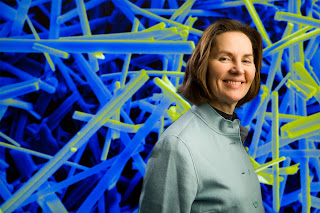BUFFALO, N.Y. -- Diamonds and gold may make some hearts flutter on Valentine's Day, but in a University at Buffalo laboratory, silver nanoparticles are being designed to do just the opposite.
The nanoparticles are part of a new family of materials being created in the laboratory of SUNY Distinguished Professor and Greatbatch Professor of Advanced Power Sources Esther Takeuchi, PhD, who developed the lithium/silver vanadium oxide battery. The battery was a major factor in bringing implantable cardiac defibrillators (ICDs) into production in the late 1980s. ICDs shock the heart into a normal rhythm when it goes into fibrillation.
Their research investigating feasibility for ICD use is funded by the National Institutes of Health, while their investigation of new, bimetallic systems is funded by the U.S. Department of Energy.
So far, their results show that they can make their materials 15,000 times more conductive upon initial battery use due to in-situ (that is, in the original material) generation of metallic silver nanoparticles. Their new approach to material design will allow development of higher-power, longer-life batteries than was previously possible.
These and other improvements are boosting interest in battery materials and the revolutionary devices that they may make possible.
"We may be heading toward a time when we can make batteries so tiny that they -- and the devices they power -- can simply be injected into the body," Takeuchi says. Right now, her team is exploring how to boost the stability of the new materials they are designing for ICDs. The materials will be tested over weeks and months in laboratory ovens that mimic body temperature of 37 degrees Celsius.
"What's really exciting about this concept is that we are tuning the material at the atomic level," says Takeuchi. "So the change in its conductivity and performance is inherent to the material. We didn't add supplements to achieve that, we did it by changing the active material directly."
She explains that new and improved batteries for biomedical applications could, in a practical way, revolutionize treatments for some of the most persistent diseases by making feasible devices that would be implanted in the brain to treat stroke and mental illness, in the spine to treat chronic pain or in the vagal nerve system to treat migraines, Alzheimer's disease, anxiety, even obesity.
And even though batteries are an historic technology, they are far from mature, Takeuchi notes. This spring, she is teaching the energy storage course in UB's School of Engineering and Applied Sciences and the class is filled to capacity. "I've never seen interest in batteries as high as it is now," she says. ###
The University at Buffalo is a premier research-intensive public university, a flagship institution in the State University of New York system and its largest and most comprehensive campus. UB's more than 28,000 students pursue their academic interests through more than 300 undergraduate, graduate and professional degree programs. Founded in 1846, the University at Buffalo is a member of the Association of American Universities.
Contact: Ellen Goldbaum goldbaum@buffalo.edu 716-645-4605 University at Buffalo















No comments:
Post a Comment